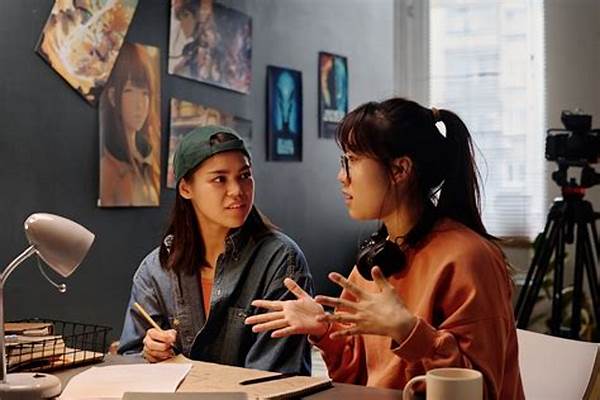In a world where technology continually pushes the boundaries of what’s possible, the fusion of art, sound, and digital creativity has become a playground for innovative minds. Imagine walking into an interactive art installation where the sounds respond to your movements, or consider an animated short film where the art intertwines seamlessly with state-of-the-art sound design—creating an experience that’s both strikingly beautiful and emotionally moving. Welcome to the realm where digital creativity blurs the lines between various media, creating audiovisual masterpieces that captivate audiences worldwide.
Read More : Benefits Of Audiovisual Sources In Historical Research Exploring Migration Tales
This enticing synergy offers not just an immersive experience but also opens up new avenues for storytelling and expression. It’s a place where creativity knows no bounds, serving as both a medium of communication and an instrument of change. If you’re someone who’s into unique experiences, this digital confluence offers exclusive access to wonderlands of imagination. Whether you’re an avid consumer or a creator, the landscape is ripe for exploration and collaboration, offering services and opportunities that didn’t exist a decade ago.
The Magic of Creative Synergy
There are countless examples of audiovisual media combining art, sound, and digital creativity that have made a significant impact in recent years.
Firstly, consider virtual reality experiences like Google Tilt Brush, where artists can paint in 3D space. It combines visual art and digital technology, allowing users to create intricate designs accompanied by custom soundscapes. This kind of digital canvas extends the possibilities of what’s achievable in traditional art forms and provides an immersive experience that traditional media can’t match.
Another compelling example is Björk’s Biophilia project, which combines music, creativity, and innovative applications. The Icelandic artist introduced an app-album that allows users to interact with music in a visual way. The project also aimed for educational purposes, serving as a teaching tool for kids in various fields, like music and science. Here, the boundaries between art, sound, and learning blur, providing an educative yet electrifying experience.
Interactive Installations and Media
Interactive installations have been pushing the envelope in terms of combining art, sound, and digital creativity. These projects invite the audience to become co-creators, making the experience more engaging and personalized. One standout project is the Rain Room by Random International. It’s an installation where visitors walk through simulated rainfall that stops whenever motion detectors sense someone’s presence, all while accompanied by a carefully choreographed soundscape. Art and technology merge to create a surreal and interactive experience.
Another shining example is Meow Wolf, an artist collective featuring immersive artistic alterations of everyday environments, melded with digital storytelling and sound effects. Their installations often incorporate a mixture of various art forms, sound, and digital elements, giving one the sensation of walking into a storybook of the future.
The Purpose of Audiovisual Innovations
Audiovisual media, combining art, sound, and digital creativity, serve not only as a form of entertainment but also as powerful tools for education and social change. By making information more engaging, these media can help convey complex topics in an accessible manner.
Detailed Examples of Successful Projects
The ability of these media to resonate emotionally is one of their strongest selling points, making them incredibly effective in fields such as marketing, where brands are constantly vying for customer attention.
Points to Consider in Audiovisual Media Design
Audiovisual media combining art, sound, and digital creativity come with numerous considerations to ensure their effectiveness and impact:
1. Cohesion: Ensure that all elements—visuals, sound, interactivity—work together harmoniously to avoid sensory overload.
Read More : An Immersive Audio-visual Led Tunnel For Luxury Event Experiences
2. Purpose: Clearly define the intent of your audiovisual piece. Are you aiming to educate, entertain, or provoke thought?
3. Audience: Understand the demographics and preferences of your target audience to tailor content that resonates.
Given the dynamic nature of audiovisual media, flexibility and adaptability are crucial in catering to ever-evolving trends and technological advancements.
Summary: The Future of Audiovisual Media
In conclusion, examples of audiovisual media combining art, sound, and digital creativity are not just captivating innovations; they are the vanguard of future storytelling, education, and marketing. These creations break traditional constraints, opening new avenues for immersive and interactive experiences that significantly engage audiences.
Harnessing these capabilities effectively requires a fine balance between artistic creativity and technological proficiency, paired with a deep understanding of the target audience. It’s this synergy that leads to impactful storytelling and brand narratives, creating memorable journeys that linger long after the experience is over.
Embracing Challenges and Opportunities
While challenges such as technological barriers and cost exist, the opportunities presented by this convergence of media far outweigh the hurdles. Innovative creators continue to push boundaries, bringing forth limitless possibilities for expression.
Whether it’s through interactive art installations, app-based experiences, or virtual reality, the scope for innovation is vast and exciting, offering fertile ground for those wanting to make a mark in the digital realm. As we advance, the role of audiovisual media in our lives will only continue to grow, shaping how we perceive, interact, and engage with the world around us.
